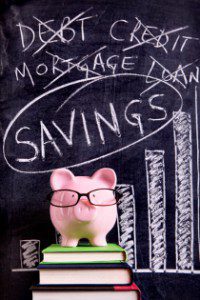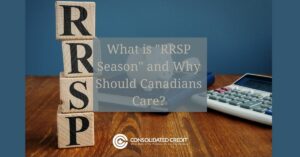Many Canadians struggle to make ends meet within the current economic climate. On top of recovering from the global pandemic, there are also interest rate hikes adding economic pressure. In July, the Bank of Canada raised the interest rate by a full percentage point to 2.5 %.
In an effort to get rising inflation, which has hit 7%, under control interest rate hikes will continue. The rising inflation has, of course, led to an increase in price for many goods and services.
This pressure will have many seeking for extra capital to get through these times. A recent poll has even indicated that many Canadians can only cover expenses by going into debt.
Though going into debt may seem like the only option, there are other ways. Debt will inevitably lead to more financial trouble, so it’s best to find an alternative. Rather than struggling to repay your debt, it can be tempting to look to your RRSP funds for help. If you have been paying into RRSP for some time, using those funds to keep afloat or pay off debt may be possible.
RRSP allow Canadians to put capital into investments to help save for retirement. These investments include mutual funds, ETFs, and stocks. The program also offers some tax benefits. While these investments stay in an RRSP you don’t pay income tax on any interest, dividends, or capital gains earned. Also, capital regularly contributed to RRSP is considered pre-tax. This means you can subtract the amount you contribute from your income and pay less in income taxes.
Though using RRSP to pay off your debt for things like credit cards may seem like a good idea, doing so comes with many caveats. This article will examine the implications of using RRSP to pay off debt. This includes the pros, cons, and alternatives.
Why you shouldn’t use your RRSP to pay off debt.
Though using RRSP to pay off debt can be viewed as a good idea by some, doing so is often not the best idea. Cashing out the money in your RRSP to cover your debts is not ideal for many reasons. Here are some examples of why:
- Saving for Retirement Restarts. When using RRSP to pay off debt, you will have to restart the process of saving for retirement. Often, with considerably less time to save for your retirement.
- Lose Compound Interest. Taking money from your RRSP will prevent the accumulation of compound interest. This can mean facing a significant loss as the building of additional interest is the main advantage of an RRSP.
- Withdrawn Money is Taxable. When capital is deducted from your annual income, it is not taxable as long as it remains within the RRSP. However, capital taken from the RRSP is fully taxable and must be added to your taxable income come tax time.
- Withholding Tax. Taking capital from an RRSP and using it for something other than purchasing a home or retirement will lead to a withholding tax. This tax means you’ll only receive a portion of the sum you withdrew. Leaving you will have less money to cover debts and losing part of your savings to the government. Making this an expensive option to pay off debt.
The cost of using your RRSP – withholding tax
The RRSP withholding tax is charged when using RRSP to pay off debt before retirement. This tax reduces the rate of your return when withdrawing from your RRSP. The rates go up as the amount taken out increases.
The rates for the RRSP Withholding Tax are currently 10% if you take up to $5,000 from your RRSP. If the withdrawal is between $5,000 and $15,000, the rate is 20%. Anything more than a $15,000 withdrawal is subjected to a 30% tax.
However, Québec residents also pay a provincial sales tax of 15%. If you are a non-resident of Canada, you pay a 25% withholding tax rate, regardless of the withdrawal size.
It is important to note that this won’t be the only tax you’ll face. Any amount withdrawn from your RRSP will count as income. This means that you have to input that amount on your tax declaration. If that additional income puts you in a higher tax bracket, you’ll have to pay more taxes.
Another downside is that you lose the RRSP contribution room and can’t re-contribute the money you take out of the account.
The taxes associated with using RRSP to pay off debt makes it only viable as a last resort. It is best to explore all other options to avoid these hefty fees.
When should you use your RRSP?
There are a few instances where using RRSP to pay off debt makes sense.
One instance is if you are using the funds to pay for your first home. Thanks to the Home Buyers’ Plan, you can withdraw up to $35,000 from your RRSP to use as a down payment for your first home. There is an important catch you’ll need to be aware of. You have to repay those funds within15 years.
Another instance would be to use the fund to finance your education. The Lifelong Learning Plan enables Canadians to withdraw funds to pay for school tuition or other educational fees. Through the plan, you can withdraw $10,000 per year for a total of $20,000. With the Lifelong Learning Plan, you have up to 10 years to repay the funds.
What should you use instead of your RRSP to pay off debt?
If you have debt that is making life much harder, you should consult a financial advisor to learn your options. They will review your situation and formulate a plan that best suits you.
Another option is to file for a debt management plan, consumer proposal or bankruptcy. This could eliminate your debt without affecting most of your long-term investments. Over time, these options can help you rebuild your credit score. Rebuilding your credit score can open up more financial opportunities for you in the future. Alternatively, using your RRSP funds to cover your debt only damages your financial situation in the long run.
Using RRSP to pay off debt may seem like a good idea, but it is a quick fix. Doing so could cause serious issues down the line.
If you are struggling with debt and are thinking of using RRSP to pay off debt, Consolidated Credit can help. Our team of Credit Counsellors can help you understand the other options available to pay off debt and avoid jeopardizing your retirement.




